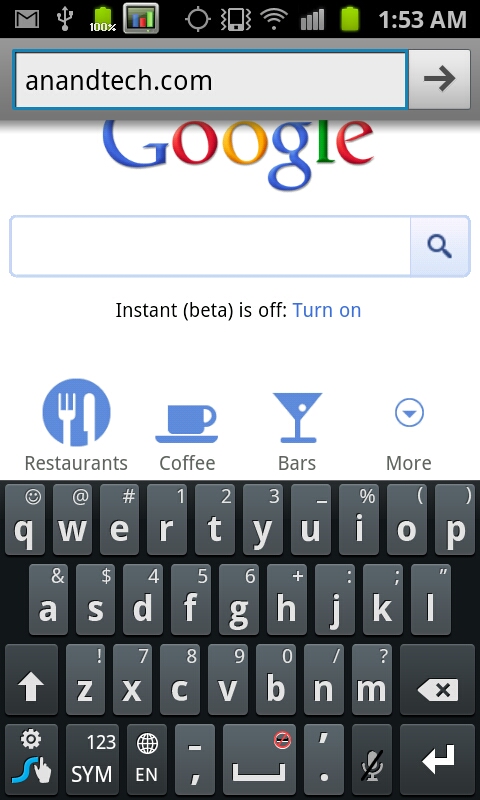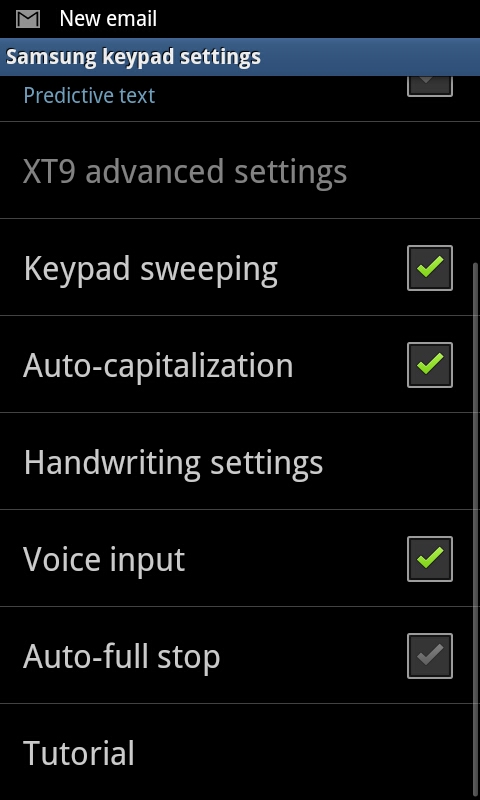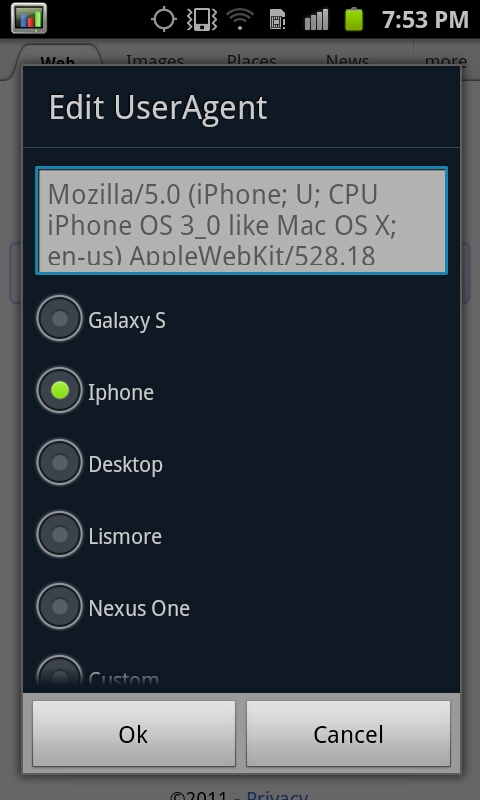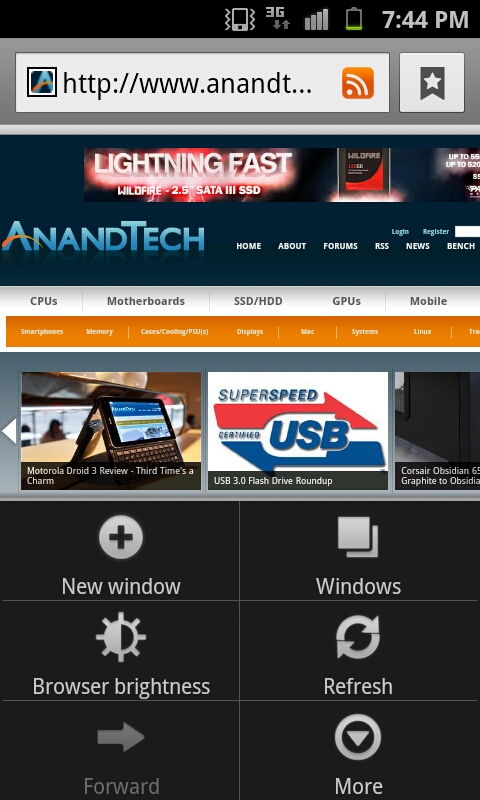Samsung Galaxy S 2 (International) Review - The Best, Redefined
by Brian Klug & Anand Lal Shimpi on September 11, 2011 11:06 AM EST- Posted in
- Smartphones
- Samsung
- Galaxy S II
- Exynos
- Mobile
Keyboards
By default, the SGS2 comes with Swype and the Samsung keypad preinstalled. I’ve moved away from Swype in recent months and started taking to the default gingerbread keyboard quite a lot, and it’s odd to see that Samsung has removed it from their stock ROMs. For me, this was one of the major enhancements that came with 2.3, and it’s puzzling how many different OEMs choose to purposefully not include it, and instead include their own strange keyboard in its place.


The Samsung keypad honestly is less than ideal and feels like it belongs back in the Android 2.1 world from whence it came, which is likely why Swype is set as default. It lacks autocorrect functionality by default and generally just looks drab.


Getting autocorrection enabled requires diving into the menus and enabling it for your given language, and even then isn’t that great. I guess I’m confused why Samsung would elect to not include the excellent 2.3 keyboard and instead force users to install the APK themselves.
Messaging
SMS is one of those things that each phone needs to do perfectly, and I think it’s especially worth taking a formal look at when an OEM moves away from the stock Android application. Bring up messaging and you get a list of ongoing conversations sorted by last activity, just like you’d expect.


Tapping new gives you a nice, clean composition page complete with character count. The conversation view is threaded and in large speech bubbles, complete with date and time stamps on each message.
Honestly I can find no fault with the Samsung messaging application. It doesn’t make the mistake that other OEMs have made by making font overly huge or decorations take away from usability and vertical space, though the composition box could stand to be a row shorter so more of the thread is visible. In addition, I spent a lot of time hammering on the SGS2’s messaging stack to try and make it slow dramatically like I’ve seen a few other Android phones do - no such lag took place, which is a great sign, even after a few weeks without deleting anything.
Browser
Like the original Galaxy S, on SGS2 samsung has made enhancements to the browser that dramatically increase smoothness. At the time we could only explain the performance increase by shrugging and claiming it was GPU accelerated. We know a bit more now about what enhancements are required to make browsing smooth in this fashion, and the answer lies in a backing store. A backing store is essentially a nice way of saying cache, and in this case what’s being cached is the rendered page itself, which is either rendered into a texture or some intermediary that’s a step above final rendering.
A backing store is what makes iOS’ browser so smooth, and you can see it render into the texture (or if you overscroll beyond the render, where it hasn’t yet) with those little grey rectangles. Render into a big texture, and then it’s a relatively free GPU operation to transform and clip that texture when a user scrolls around the page, though zooming will require a re-draw. Until Android 3.x, however, the stock Android browser hasn’t had a backing store, which is why translating around feels choppy. As a result, it has been the burden of OEMs to make their browsers feel snappy by incorporating their own backing stores. HTC works with Qualcomm to bring an appropriate level of smoothness to their devices, I already mentioned Android 3.x has one (which will no doubt carry over to Ice Cream Sandwich), and Samsung again has one this go-around in SGS2 just like they did with the original SGS.


So how good is SGS2’s browser backing store? Very good. Far and away this is the smoothest Android 2.x browsing experience, by a large margin. The only downside to the whole thing is that the browser has 16 bit color, again undoubtedly to make this an easy texture for manipulation by the GPU. I’ve also noticed one or two times that the browser will go to a white screen instead of showing the content after it’s loaded, which to me indicates that getting the backing store always working perfectly with a big page can be a challenge - perhaps GPU memory is at a real premium when this happens. I’m told this is fixed in newer firmware editions. That said, the tradeoff is well worth it, as zooming, translating, just about everything is buttery smooth. Browser smoothness is finally basically at parity with iOS.
What’s very impressive is that Samsung even manages to keep Flash 10.3 plugins animated while panning and scrolling around, something that currently HTC temporarily halts while translating around in their browser. It’s hard to communicate just how smooth and fluid the SGS2 browser is, and I’d encourage interested parties to watch our video which demonstrates it.
Finally, there’s one last semi-hidden browser feature - custom user agents. Enter “about:useragent” into the URL bar, and you can pull up a menu and select between a number of different user agents and masquerade the SGS2 as an iPhone, Galaxy S, Desktop (OS X 10.5.7 Safari), Nexus One, Lismore, or custom. This is something again I wish the stock Android browser would offer similar control over.










132 Comments
View All Comments
shamalh108 - Monday, September 12, 2011 - link
Thanks alot, going to do that today, however if you read my post above im not sure its an individual app causing it. Maybe i should root so i can wipe the battery stats and recalibrate, besides that im also going to purchase the offical extended battery from samsung, i dont mind losing slight slimness:)ph00ny - Monday, September 12, 2011 - link
I didn't even bother with rooting for a month or two until i wanted to try out chainfire plugins. Even in stock form, battery life was great. certainly better than my captivate.One thing to understand about SAMOLED screen is that it uses 0 power on black pixel and more power on white pixels. So maybe try out a darker themed wall paper and also check to see if you have widgets that have tendency to use up more juice than an alternative
Also for an example, samsung's stock music app uses roughly half of Google's music app power consumption. It gets worse with spotify (offline mode of course)
Remeniz - Monday, September 12, 2011 - link
The trick is to adjust the power saving features to suit and make sure very little is going on in the back ground. I only run GPS if I need too and the WiFi gets turned off when i'm out and about, unless I know i'm in a WiFi zone and want to browse the www.I get at least a days use out of my SGS2.
supercurio - Monday, September 12, 2011 - link
Note:"When idle, processor goes back to 200 MHz"
Idle - screen on or an using a wakelock to keep the device on its the case.
Otherwise the whole CPU is turned literally OFF − everything frozen in RAM.
And in this situation, the baseband, Wi-fi chip or an external timer will wake up the CPU and restore Linux kernel in a working state when needed, like if you received a new mail, or a phone call.
I precise that because most people believe the CPU stays ON all the time but it's the opposite, with standard usage, the CPU is ON only a fraction of the day.
Lucian Armasu - Sunday, September 11, 2011 - link
Brian, I don't think it's fair to compare the "tablet" version of A5 with the "smartphone" version of the Exynos and all the other chips. Even Nvidia's Tegra 2 has either 50% or 100% higher clock frequency for its GPU in the tablets, compared to the one in smartphones.It's very likely that all tablet chips are more powerful than the smartphones ones, and for all we know the iPhone 5 GPU will only one 1 GPU core instead of 2 like in the iPad 2, or they'll be clocked at a lower frequency.
I know you'll review the iPhone 5, too, but I think you're setting a too low expectation for the Exynos and the others compared to the "A5 chip". You know what I mean? You should've at least thrown a Xoom or a Transformer in there to see how it fairs against the Tegra 2 phones.
I hope at least you'll correct this in future reviews. Great review otherwise, though.
privater - Sunday, September 11, 2011 - link
An iPad 2 can run sun spider 0.9 with 1980 score (4.3.5)If the Exynos is superior on every aspect of A5, the result is difficult for me to understand.
Lucian Armasu - Sunday, September 11, 2011 - link
Just as I mentioned above, it's not fair to compare the tablet versions with the phone versions of the chips. All the latest smartphones get around 4000 in the Sun Spider test, but all tablets get around 2000 in that test, so even on the CPU side, it's still not a fair comparison.Mike1111 - Sunday, September 11, 2011 - link
Great review!But why are you so late with the review of the INTERNATIONAL version? I mean I would get it if you decided to wait for the US versions, but waiting almost 4 1/2 months and then publish a review of the international version only a week before the US versions get released? Seems strange to me...
ph00ny - Sunday, September 11, 2011 - link
Brian said in the other reviews comment sections that he was waiting to get ahold of a review unit. I did offer mine if he was nearby but he's nearly on the west coast and i live in the opposite side of the countryshamalh108 - Sunday, September 11, 2011 - link
Another pity is that even games from gameloft which are supposed to be adapted to the SGS2 cause significant heating of the phone.. for example the Asphalt 6 available for free in Samsung Apps .. it would be great if more games were coded to make better use of the SGS2 gpu ...